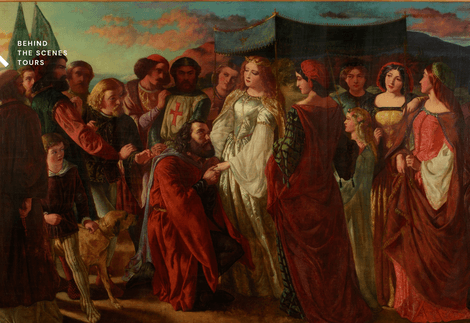U3A Shipley store tours
The local U3A group has kindly given us the scripts from some of their store tours, to help our visitors enjoy our collections from home.
'The Molo, Venice, Looking West, in the style of the artist Antonio Canaletto
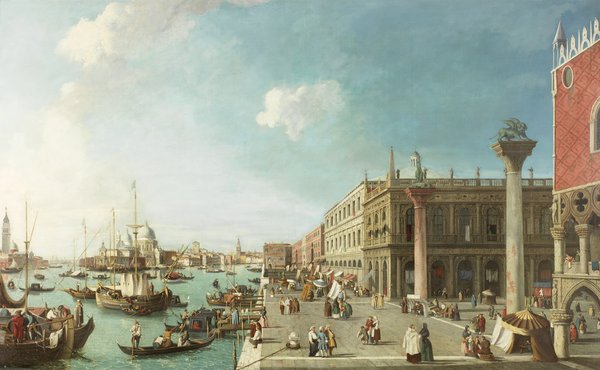
Antonio Canaletto (style of) (1697-1768), ‘Grand Quay, Venice: Church of Santa Maria Della Salute’ or ‘The Molo, Venice, Looking West’, oil on canvas, c1750
The name on the frame of the painting is Luca Carlevaris (1663 - 1730) yet the date of the work is given as 1735 – 1765. A bit of a mystery! Carlevaris was an Italian painter and engraver of landscapes. He studied mathematics, science, perspective and architecture in order to follow his father’s profession before becoming an artist. He worked mostly in Venice and is regarded as the father of 18th century Venetian view painting (vedute) and his paintings of Venice are among the earliest Baroque depictions of the city. His interest in mathematics is reflected in his rigorous perspective settings and his works were the foundation on which Canaletto, who was a pupil of Carlevaris, built. However, because the costumes depicted are too late for Carlevaris, this painting has been dated as being produced in about 1750.
Caneletto (1697 -1768) was born in Venice, the son of Bernardo Canal. He served his apprenticeship with his father, a theatrical scene painter, and started to paint the daily life of the city and its people after becoming interested in vedute paintings. He studied under Carlevaris and produced a great number of paintings, which were bought by people from England. He came to London to paint scenes and to be near his clients who would buy them.
Grand Quay, Venice: Church of Santa Maria Della Salute’ or ‘The Molo, Venice, Looking West’ is full of detail and is lit from the left showing strong light and shade of cool, low, grey and green shadows. The view from the Molo (quay) shows the entrance to the Grand Canal at the right of the church of Santa Maria della Salute.
To the right of the quay there is a column of St. Mark, the patron saint of Venice, with a winged lion on top (the symbol of St. Mark and of Venice, and one of St. Theodore who was a previous patron saint. On the quay there are a number of temporary canvas booths. To the right at the foot of the column there are men with bird cages.
There is a stage with a performer and audience. There is washing hanging out. There are people on balconies observing the scenes below. To the front left there is a ship unloading, the moving of a barrel being observed by an official.
The lagoon is busy with gondolas ferrying people and other boats carrying out business. One would have to look at this painting for a long time to take in all the details.
William Bromley (1769-1842), ‘The Escape’, oil on canvas, c19 century

William Bromley (1769-1842), ‘The Escape’, oil on canvas, c19 century
William Bromley was an engraver and artist, apprenticed to an engraver named Wooding in London. He began exhibiting at the Royal Academy in 1786 and at the Society of Artists in 1790. He was employed to engrave several paintings commemorating the Napoleonic wars, including A.W. Devis's ‘Death of Nelson’ (1812) and Thomas Lawrence's portrait of the Duke of Wellington (1818). In 1822, Bromley began exhibiting engravings of the Elgin marbles. These were made for the trustees of the British Museum. He continued to exhibit these engravings nearly every year until 1835. Bromley was the first of a large family of engravers, including his sons John Charles and James Bromley.
The mood of this painting, 'The Escape' is captured by the muted use of a range of colour which creates and eerie but treacherous early morning scene. The pastel colours of the sky and lake contrast with the darker colours of the beautiful mountains surrounding the lake as well as the figures within the boat. It is a beautiful scene, which is marred by the events taking place on the Lake.
Within the boat are apparently two women huddled in their cloaks at the back of the boat. They are heavily guarded by a well-dressed gentleman who may be a soldier guarding the women with a rifle at the ready. There are four oarsmen sailing the ship as fast as they can. All passengers are looking to their pursuers who seem to gaining fast. The artist creates tension and fear in this painting. Little information is available regarding the subject of this painting. However, perhaps it is the escape of Bonnie Prince Charlie, who was said to be disguised as a woman.
Also known as 'the Young Pretender', Princes Charles Edward Stuart was the grandson of the deposed Catholic King James VII of Scotland and II of England. He and his followers believed the throne of Great Britain rightfully belonged to the House of Stuart, and led the campaign, known as the Jacobite Risings of 1745, to overthrow King George II. Although the handsome prince and his troops experienced some successes in battle against the Hanoverian forces, Charles was eventually halted at the Battle of Culloden in 1746 by the Duke of Cumberland and the Red Coats; the bloody clash was to be the last major battle ever fought on the British soil. The tale of the Bonnie Prince Charlie's escape is now legendary. On the run from his Hanoverian enemies, he desperately sought a ship in which to escape from Scotland. In the process, he and a few companions secretly trekked for five hundred miles over remote mountainous areas of the Western Isles and the North-West Highlands of Scotland. Eventually, he was rescued by friends, and taken to France.
David Wilkie Wynfield (1837-1887), ‘The Lady’s Knight’, oil on canvas, 186
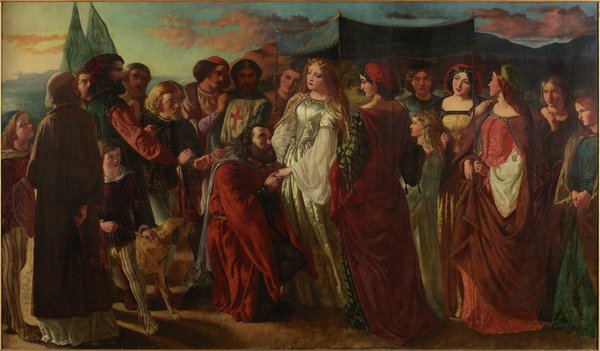
David Wilkie Wynfield (1837-1887), ‘The Lady’s Knight’, oil on canvas, 1860
Wynfield was related to the Scottish artist David Wilkie. He studied at Leigh’s Art School in the 1850s. His first painting was accepted for the Royal Academy summer exhibition in 1859. Wynfield associated with a group of artists known as the St John’s Wood Clique. He painted many works set in medieval or Renaissance Europe concentrating on the romantic problems of couples and families.
In the 1860’s he became interested in photography. He developed a technique of shallow focus portrait photography. The combination of soft focus, large format print and historical costumes produced a photographic style that was completely original at the time. Wynfield was attempting to imitate the effects of Old Masters such as Titian using the new medium of photography. Wynfield served in The Artists Rifles. He reached the rank of Captain and was commanding “H” Company in 1880. In his autobiography, his friend Henry Stacy Marks said Wynfield died of consumption.
The painting depicts the historical scene of the White Queen standing at the water’s edge saying farewell to her two sons, the princes, and their departure to France. The artist has captured the emotion of the situation. The distressed queen and her ladies in waiting around her as well as her loyal knight who promise safe passage for the princes. Queen Elizabeth Woodville was the wife of Edward IV and it better known as “the White Queen”. Her four children included the two princes who were murdered in the Tower of London and Elizabeth of York who was to become the mother of King Henry VIII. She has recently been brought to public attention through the BBC Historical Drama “The White Queen” (2013).
The colours are rich and reflect from the queen’s white gown and golden hair. The picture created reflects a fairy-tale scene. Although the story is true the artist does not present the reality of the situation or the accuracy of history. In this painting Wynfield is undoubtedly influenced by his work with photography and colour. The colours are almost too garish. However, the melancholy of the situation has been crated to reflect the historical perspective of the day.
Philip Richard Morris (1838-1902), ‘Beach with Figures’, oil on board, 19th century
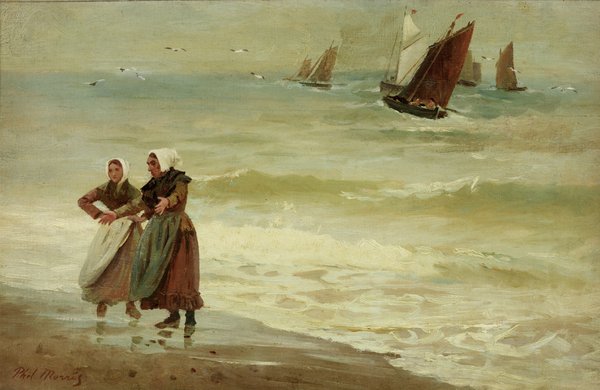
Philip Richard Morris (1838-1902), ‘Beach with Figures’, oil on board, 19th century
Philip Richard Morris was a biblical and historical genre painter. He was the son of an engineer and iron founder and was apprenticed to an engineer. Initially he painted during his spare time as his employer refused, even at the intercession of the artist William Holman-Hunt who had become his friend, to cancel his indentures. Hunt encouraged him to study painting and to draw on the resources of the museums in London, specifically the Elgin Marbles at the British Museum.
After his apprenticeship, Morris began to study full time at the Royal Academy schools in 1855. At the end of his first year he won a silver medal. In 1856 he won two more medals. He exhibited his first two paintings at the Royal Academy in 1858 and one of them, The Good Samaritan, was awarded a gold medal. The artist Thomas Creswick, R.A, purchased the other painting of that year, g .
This early acclaim earned Morris a Travelling Studentship and he went to France and Rome to continue his studies. He resumed exhibiting at the Royal Academy in 1860 upon his return to London. He continued to exhibit there until 1901, a year before his death. He also showed at the British Institution, Suffolk Street and the Grosvenor Gallery. He was elected an Associate of the Royal Academy in 1877. Three of his paintings - The Sailor's Wedding (RA, 1876), The Mowers (RA, 1875) and Reaper and the Flowers (1878) were included at the Paris Exposition Universelle in 1878. In his later years he turned almost entirely to portrait painting.
The painting held here at the Shipley highlights the figures of 2 fisherwomen in the foreground of the painting. The women are standing at the water’s edge. Behind the two women the sea is green and very choppy. The sky is dull and grey. Both women have on aprons and hats, it is clear it is windy as their clothes flap in the breeze. There are six fishing boats heading out to sea in full sail.
The colours are muted; the boats seem surrounded by a Spray. The women on the other hand are much clearer and very expressive. They appear to be talking or signalling to someone. The woman in the foreground is holding out her hands as if perhaps describing the size of a fish. The second woman has her hands on her hips, paying attention to what is being said.
Although this painting is not one of the most well-known of the artist, it is recognisable of his style, his mastery of the story and context, and his detail of colour and atmosphere.
Thomas Marie Madawaska Hemy (1852-1937), ‘On the Lookout’, oil on canvas, 1878
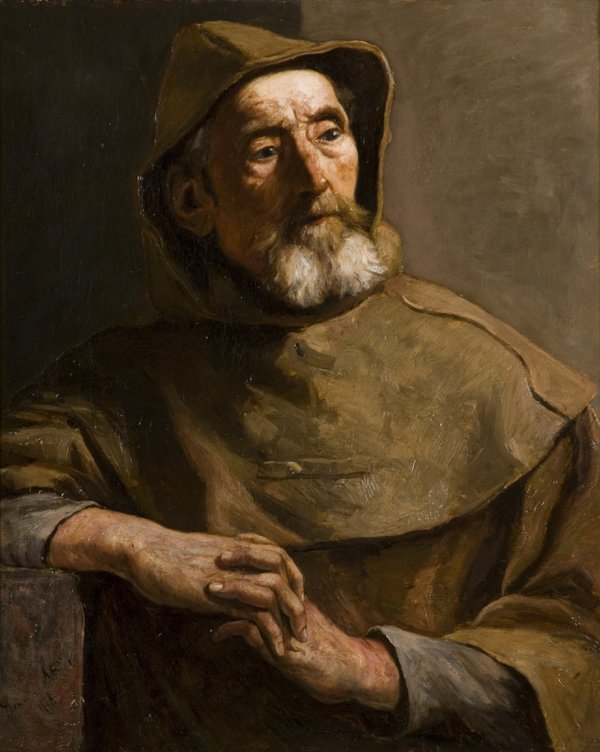
Thomas Marie Madawaska Hemy (1852-1937), ‘On the Lookout’, oil on canvas, 1878
Thomas Hemy was born on the passenger ship SS Madawaska while his family were on route from Newcastle to Australia. After two and a half years his family returned to Newcastle before later moving to North Shields, where he gained tuition in art from his uncle, Isaac Hemzell. Hemy spent several years at sea and endured a shipwreck.
When he returned to Newcastle, he attended the Town’s School of Art at which time he exhibited for the first time. Within a year his work was shown in the Dudley Gallery, London. His work came to the attention of John George Sowerby, who sent him to study drawing under Verlat in Antwerp, Holland.
He produced several figure studies, but he was better known for his costal and river scenes. He was a marine and costal painter who opted for watercolours and oils.
In this picture an old weather-beaten sailor is leaning against a post on “look out” duty. He is wearing waterproofs and a hooded cape to protect him from the rain and salt spray. His expression is very calm, and he seems deep in thought, a contrast to the frantic activity, which would happen if he saw danger to the ship. He exudes a man who is at one with the sea, possessing skill and years of hard experience.
As a postscript, anyone walking into the main foyer of the Stadium of Light in Sunderland can’t help but notice the stunning painting of the fixture between Sunderland and Aston Villa played at Sunderland football clubs then home ground, Newcastle Road.
This English first division match, played on 2 January 1895 ended 4 v 4 and was nothing special, however the painting is recognised as the oldest of an Association Football match anywhere in the world, marks it out as something special.
In celebration of Sunderland AFC’s third English league championship in 1894/95 the football club commissioned Hemy, a local North East artist, to paint a picture of the team in action and the game against Villa was the match chosen. The painting has over the years had two titles; “A Corner Kick” and “The Last Minute – Now or Never” but is commonly known as the “Hemy Painting”.
John Atkinson Grimshaw (1836-1893), ‘Greenwich, Half Tide’, 1884
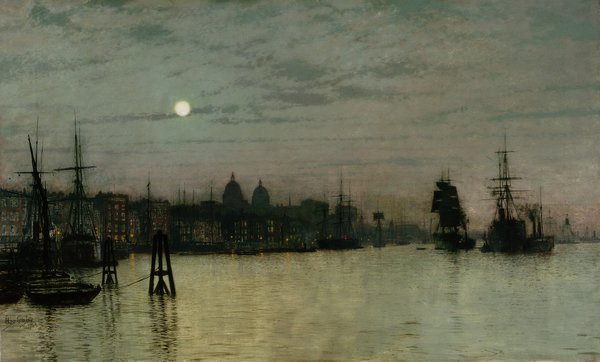
Grimshaw was a Victorian artist known for his city night scenes and landscapes. In 1861 at the age of 24 years, he left his job as a clerk for the Great Northern Railway to become a painter. He first exhibited in 1862, mostly painting birds, fruit, and blossom under the patronage of the Leeds Philosophical and Literary Society. He became successful in the 1870s and rented a second home in Scarborough, which became a favourite subject. Grimshaw soon became rich enough to rent Knostrop Old Hall near Leeds.
Grimshaw’s primary influence was the Pre-Raphaelites from whom he started to depict the contemporary world through the creation of realistic settings of the industrial landscapes including the industrial towns of the north and the Victorian docks and waterfronts. He was renowned for creating atmospheric paintings through capturing the chill in the damp air, the moisture penetrating the heavy clouds, the early morning dawn and the eeriness of the moonlight. He created landscapes of accurate colour, lighting, vivid detail and realism. His later work included imagined scenes from the Greek and Roman empires, and he painted literary subjects from Longfellow and Tennyson.
The artist’s skill in creating effective lighting illuminates the moonlit view of Greenwich at half-tide. The silhouettes of the buildings and the ships stand out tall and dark against the pale blue and pink sky. The moonlight glimmers on the water with soft reflective lights and shadows, creating a vividly eerie scene. Grimshaw’s realism captures the mood and appearance of the setting in minute detail.
In an obituary notice for Grimshaw, the reviewer ended a survey of his career with the following words: “Daylight effects have little attraction for him; the details were too hard and staring; and it was the mystery of the murky air, the tender hues of dawn, or the mellow light of the moon thrown on all beneath it, a silvery radiance that appealed to him most deeply. It may be said without exaggeration he left no successor behind him”
Nicholas Pocock (1740-1821), ‘Sea Piece with British Men of War’, 1800-1810
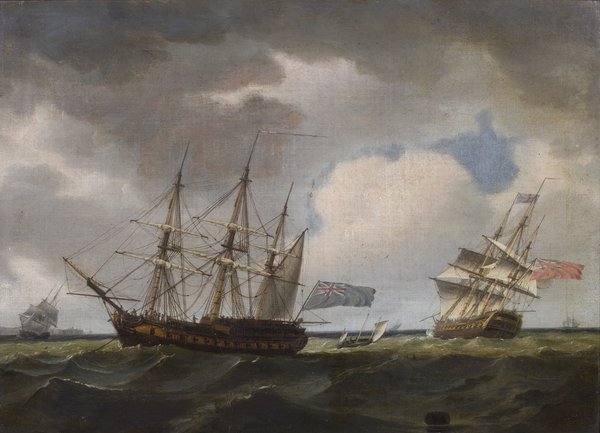
Nicholas Pocock (1740-1821), ‘Sea Piece with British Men of War’, oil on canvas, 1800-1810
Nicholas Pocock was a British artist known for his numerous and historical seascapes. He was born in Bristol in 1740, the son of a seaman, and followed in his father's profession and was master of a merchant ship by the age of 26. During his time at sea, he became a skilled artist by making ink and wash sketches of ships and coastal scenes for his logbooks.
In 1778, Pocock's employer, Richard Champion, became financially insolvent due to the effects of the American Revolutionary War on transatlantic trade. As a result, Pocock gave up the sea and devoted himself to painting. The first of his works were exhibited by the Royal Academy in 1782.
Later that year, Pocock was commissioned to produce a series of paintings illustrating George Rodney's victory at the Battle of the Saintes. In 1789, he moved to London, where his reputation and contacts continued to grow. He was a favourite of Samuel Hood and was appointed Marine Painter to King George.
Pocock's naval paintings incorporated extensive research, including interviewing eyewitnesses about weather and wind conditions as well as the positions, condition, and appearance of their ships; and drawing detailed plans of the battle and preliminary sketches of individual ships. He was also present himself at the Glorious First of June in 1794, on board the frigate HMS Pegasus. In addition to his large-scale oil paintings depicting naval battles, Pocock also produced many watercolours of coastal and ship scenes.
This painting highlights the distinctive style of the artist. The movement in the picture is exemplified with the turbulent dark sea, the storm clouds in the sky and the sway of the ship of the British Men of War. A storm is brewing and yet there is evidence that the sky is brightening over the English ship. Perspective is accurately presented with the ships in the foreground and the lesser ships in the background. The painting is full of activity with the battle ships facing each other. Pocock's extensive research is reflected in the factual accuracy of the scene, making the painting an important contributor to maritime history.
Claude Lorrain (1604 – 1682), ‘The Embarkation of St Ursula’

Claude Lorrain (1604 – 1682), ‘The Embarkation of St Ursula’, oil on canvas
Claude Lorrain was a French painter, draughtsman and etcher of the Baroque era. He spent most of his life in Italy, and is one of the earliest important artists, to concentrate on landscape painting. His landscapes are usually turned into the more prestigious genre of history paintings by the addition of a few small figures, typically representing a scene from the Bible or classical mythology.
On his travels, Lorrain briefly stayed in Marseilles, Genoa and Venice, and had the opportunity to study nature in France, Italy, and Bavaria. By the late 1620s the artist had a habit of sketching outdoors, particularly at dawn and at dusk, making oil studies on the spot. The first dated painting by Claude, “Landscape with Cattle and Peasants” in 1629. This painting demonstrated the artist’s well-developed style and technique. In the next few years his reputation grew steadily, as evidenced by commissions from the French ambassador in Rome (1633) and the King of Spain (1634–35). From this point, Claude's reputation was secured. He went on to fulfil many important commissions, both Italian and international. In about 1636 he started cataloguing his works, making pen and wash drawings of nearly all his pictures as they were completed.
In 1650 Claude moved to a house in Via Paolina (today Via del Babuino), where he lived until his death. After his death, he owned only four of his paintings, but most of his drawings were in bound volumes. Five or six large bound volumes were left to his heirs.
Claude's lack of interest in avoiding any evidence of realism is perhaps seen most clearly in the ships in his harbour scenes. Whether the subject, and the dress of the figures is supposed to be contemporary, mythical or from Roman or medieval history. The large ships in this painting reflect this position. All his ships are usually presented as up-to-date merchant vessels, usually all like each other. It has been suggested that the figures and buildings in the painting are figments of Claude’s imagination also. Some large rowed galleys are also seen in this painting and reflects an ancient setting. However, Claude’s variance in styles and genres in many ways work to create a pleasing if not mythical setting.
Eugene McSwiney (1866-1930), ‘Landing A Catch, A’

Eugene McSwiney (1866-1930), ‘Landing A Catch, A’, oil on canvas (early 20th century)
Eugene Joseph McSwiney was born in County Cork, in 1866, the son of a leather merchant. He studied drawing and painting at the Cork School of Art, winning a series of awards for his figurative skills. For a short time, he attended the Royal College of Art in London and joined the staff of the Crawford School of Art in the city of Cork. He exhibited work at the Royal Hibernian Academy, exhibiting over forty paintings here over the years, and several works at the Royal Academy. Notable works include “Eventide” (1987) and “Ruins of Tomileague Abbey, County Cork” (1912) and became known primarily for his landscapes of the Englsh countryside. Later in life he struggled to earn a living from his paintings and died in London at the age of 70.
In his painting ‘Landing the Catch’, (early 20th century), we can see two figures in the foreground, those of an older man and a younger woman. They are wearing light clothing, which seems to suggest that the scene occurs during the warmer weather and the clouds have a slightly pink tone, indicating that it is nearly sunset and the end of a day’s fishing. The man is dressed in his work clothes, wearing a cap and is kneeling on the sand with a basket of fish before him and another by his side, examining his catch. The baskets are full to the brim, so this has obviously been a satisfying day. The young woman wears a skirt and blouse with an apron and a neckerchief around her neck. She has a basket on her left arm and is pointing to the boat, in which we see two other figures. Has she come down to the shore to welcome them home and see that all is well?
The two people in the small fishing boat, or cobble, seem to be two much younger men or boys, which might mean this a family concern. They are looking down; perhaps there are more fish to be landed.
It must be a fairly windy day, because in the background, we can see another vessel bending over to the right in the wind. We can see the breakers buffet it about, behind the figures in the foreground. Seagulls are swirling around this other boat, hoping to gather up any fish thrown overboard.
Thomas Swift Hutton (c1860 – 1935), ‘The Needle’s Eye, Berwick-on-Tweed’, 1898
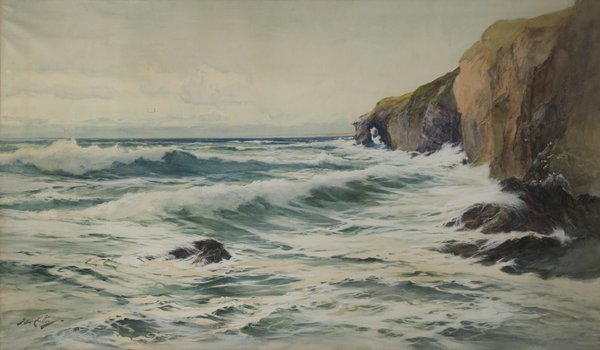
Thomas Swift Hutton (c1860 – 1935), ‘The Needle’s Eye, Berwick-on-Tweed’, watercolour, 1898
T. S. Hutton was born in Edinburgh in 1860, and after living in Liverpool for a time moved to Newcastle. Whilst here he painted watercolours of beautiful scenes of Northumberland, the North East coast, including Cullercoats, and Yorkshire at Staithes. He returned to Scotland in 1906, living in Glasgow and continued his career. During his lifetime he exhibited paintings at Berwick Club, the Royal Academy, Glasgow Institute of Fine Arts and the Scottish Academy, as well as at other major galleries throughout the British Isles. His work is still popular today and you can see another of his paintings at South Shields Museum and Art Gallery.
The painting depicts a coastal scene of a well-known landmark near Berwick on Tweed, The Needles Eye. Hutton did paint in oils, but he had a preference for watercolours. He also used a variety of different materials on which to paint. The larger works, such as this one, are painted on paper made from heavy pulp or rags.
For smaller works he often painted on small boards. Some of these are thought to have come from old shirt boxes.
In this picture, he has captured the turbulent movement of the waves as they are dashed against the cliffs on a windy day. It is painted in a more dynamic and dramatic style than many of his other works that have a more tranquil, subdued mood. Another painting of his in a similar style is called “Breezy day, Holy Island”.
John Wallace (1841-1903), ‘Killingham (Killinghall) Mill’, 1900

John Wallace (1841-1903), ‘Killingham (Killinghall) Mill’, oil on canvas, 1900
John Wallace was born in Ryton in 1841, the son of Henry Wallace, a cartwright. He is also known as George Pipeshank and John C. Wallace. After becoming a joiner, he branched out into property development in Ryton and by age 27 was a successful businessman with a wife and family. During a period of recession in the building trade, he took up painting, taking lessons from a local artist, and soon abandoned the building trade to devote himself to painting, He exhibited at the Newcastle Arts Association in 1880 & 1881, and was a prominent member of the ‘Bewick Club’, founded in 1884, and whose aim was to promote the needs of professional artists and encourage not only the patronage of rich individuals, but also that of the less wealthy. Wallace exhibited at the Scottish Academy in Edinburgh and at the Royal Academy in 1892, 1896 & 1902.. He became a successful artist, he could afford to move with his family to a newly built house in Kinglsley Place, Heaton, overlooking the newly opened Heaton Park. He lived here from 1891, until his death, 20 years later.
John Wallace painted Killinghall Mill in 1900, a popular spot for artists. The corn mill at Killinghall is 3 miles north of Harrogate, and the painting is an accurate depiction as it was in the early 20th century. When he painted it the mill was the home of William Grainger aged 54, a corn miller, his wife, Ann, and two of their children, a daughter and a son. We see the warm, mellow tones of the rather square buildings of the mill, as it stands on the bank of the River Nidd in North Yorkshire. Water cascades over the weir in front of the mill and flows under the arch beneath the rather dilapidated building on the left of the painting.
The painting has a lively, photographic quality. One can almost imagine oneself standing in front of the scene, as the water flows smoothly past. • Killinghall village dates back before the Norman Conquest. Evidence can date it back to Celtic times, and is named in the Domesday Book as Chenihalle i.e. Kennelhall, which possibly means a place where the Lord of the Manor kept his hounds. Mastiff dogs were kept by Saxon Lords to drive away wolves from their land. The mill seems to have survived until at least the 1930s, but has now made way for modern housing development. Today the village is described as a commuter village. The manor now belongs to the Duke of Devonshire.
Support us
As a charity we rely on donations and our closure, whilst necessary, has significantly impacted our income. If you are able, please help us through this difficult period by donating online or via text. Text TWAM 3 to give £3, TWAM 5 to give £5 or TWAM 10 to give £10 to 70085. Texts cost your donation plus one standard message rate. Thank you from everyone at the Shipley Art Gallery.

/https://s3-eu-west-1.amazonaws.com/atwam-images-files/production/images/content/shipleyartgallery/2020-07/351901.jpg)
